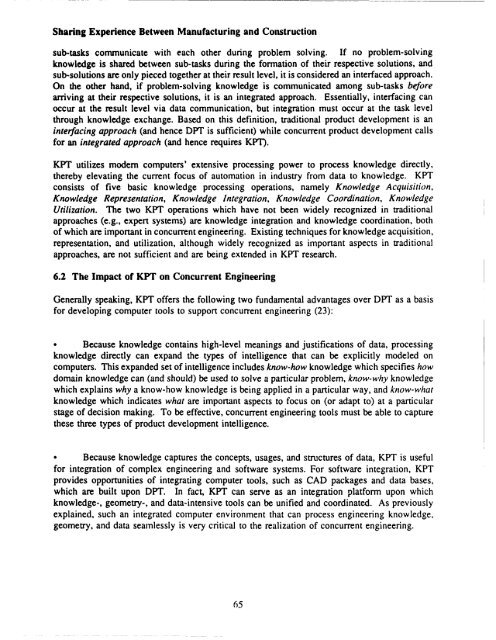Challenges and Opportunities for Innovation in the Public Works ...
Challenges and Opportunities for Innovation in the Public Works ...
Challenges and Opportunities for Innovation in the Public Works ...
You also want an ePaper? Increase the reach of your titles
YUMPU automatically turns print PDFs into web optimized ePapers that Google loves.
Shar<strong>in</strong>g Experience Between Manufactur<strong>in</strong>g <strong>and</strong> Construction<br />
sub-tasks communicate with each o<strong>the</strong>r dur<strong>in</strong>g problem solv<strong>in</strong>g. If no problem-solv<strong>in</strong>g<br />
knowledge is shared between sub-tasks dur<strong>in</strong>g <strong>the</strong> <strong>for</strong>mation of <strong>the</strong>ir respective solutions, <strong>and</strong><br />
sub-solutions are only pieced toge<strong>the</strong>r at <strong>the</strong>ir result level, it is considered an <strong>in</strong>terfaced approach.<br />
On <strong>the</strong> o<strong>the</strong>r h<strong>and</strong>, if problem-solv<strong>in</strong>g knowledge is communicated among sub-tasks be<strong>for</strong>e<br />
arriv<strong>in</strong>g at <strong>the</strong>ir respective solutions, it is an <strong>in</strong>tegrated approach. Essentially, <strong>in</strong>terfac<strong>in</strong>g can<br />
occur at <strong>the</strong> result level via data communication, but <strong>in</strong>tegration must occur at <strong>the</strong> task level<br />
through knowledge exchange. Based on this def<strong>in</strong>ition, traditional product development is an<br />
<strong>in</strong>terfac<strong>in</strong>g approach (<strong>and</strong> hence DPT is sufficient) while concurrent product development calls<br />
<strong>for</strong> an <strong>in</strong>tegrated approach (<strong>and</strong> hence requires KPT).<br />
KPT utilizes modem computers' extensive process<strong>in</strong>g power to process knowledge directly,<br />
<strong>the</strong>reby elevat<strong>in</strong>g <strong>the</strong> current focus of automation <strong>in</strong> <strong>in</strong>dustry from data to knowledge. KPT<br />
consists of five basic knowledge process<strong>in</strong>g operations, namely Knowledge Acquisition,<br />
Knowledge Representation, Knowledge Integration, Knowledge Coord<strong>in</strong>ation, Knowledge<br />
Utilization. The two KPT operations which have not been widely recognized <strong>in</strong> traditional<br />
approaches (e.g., expert systems) are knowledge <strong>in</strong>tegration <strong>and</strong> knowledge coord<strong>in</strong>ation, both<br />
of which are important <strong>in</strong> concurrent eng<strong>in</strong>eer<strong>in</strong>g. Exist<strong>in</strong>g techniques <strong>for</strong> knowledge acquisition,<br />
representation, <strong>and</strong> utilization, although widely recognized as important aspects <strong>in</strong> traditional<br />
approaches, are not sufficient <strong>and</strong> are be<strong>in</strong>g extended <strong>in</strong> KPT research.<br />
6.2 The Impact of KPT on Concurrent Eng<strong>in</strong>eer<strong>in</strong>g<br />
Generally speak<strong>in</strong>g, KPT offers <strong>the</strong> follow<strong>in</strong>g two fundamental advantages over DPT as a basis<br />
<strong>for</strong> develop<strong>in</strong>g computer tools to support concurrent eng<strong>in</strong>eer<strong>in</strong>g (23):<br />
• Because knowledge conta<strong>in</strong>s high-level mean<strong>in</strong>gs <strong>and</strong> justifications of data, process<strong>in</strong>g<br />
knowledge directly can exp<strong>and</strong> <strong>the</strong> types of <strong>in</strong>telligence that can be explicitly modeled on<br />
computers. This exp<strong>and</strong>ed set of <strong>in</strong>telligence <strong>in</strong>cludes know-how knowledge which specifies how<br />
doma<strong>in</strong> knowledge can (<strong>and</strong> should) be used to solve a particular problem, know-why knowledge<br />
which expla<strong>in</strong>s why a know-how knowledge is be<strong>in</strong>g applied <strong>in</strong> a particular way, <strong>and</strong> know-what<br />
knowledge which <strong>in</strong>dicates what are important aspects to focus on (or adapt to) at a particular<br />
stage of decision mak<strong>in</strong>g. To be effective, concurrent eng<strong>in</strong>eer<strong>in</strong>g tools must be able to capture<br />
<strong>the</strong>se three types of product development <strong>in</strong>telligence.<br />
* Because knowledge captures <strong>the</strong> concepts, usages, <strong>and</strong> structures of data, KPT is useful<br />
<strong>for</strong> <strong>in</strong>tegration of complex eng<strong>in</strong>eer<strong>in</strong>g <strong>and</strong> software systems. For software <strong>in</strong>tegration, KPT<br />
provides opportunities of <strong>in</strong>tegrat<strong>in</strong>g computer tools, such as CAD packages <strong>and</strong> data bases,<br />
which are built upon DPT. In fact, KPT can serve as an <strong>in</strong>tegration plat<strong>for</strong>m upon which<br />
knowledge-, geometry-, <strong>and</strong> data-<strong>in</strong>tensive tools can be unified <strong>and</strong> coord<strong>in</strong>ated. As previously<br />
expla<strong>in</strong>ed, such an <strong>in</strong>tegrated computer environment that can process eng<strong>in</strong>eer<strong>in</strong>g knowledge,<br />
geometry, <strong>and</strong> data seamlessly is very critical to <strong>the</strong> realization of concurrent eng<strong>in</strong>eer<strong>in</strong>g.<br />
65







